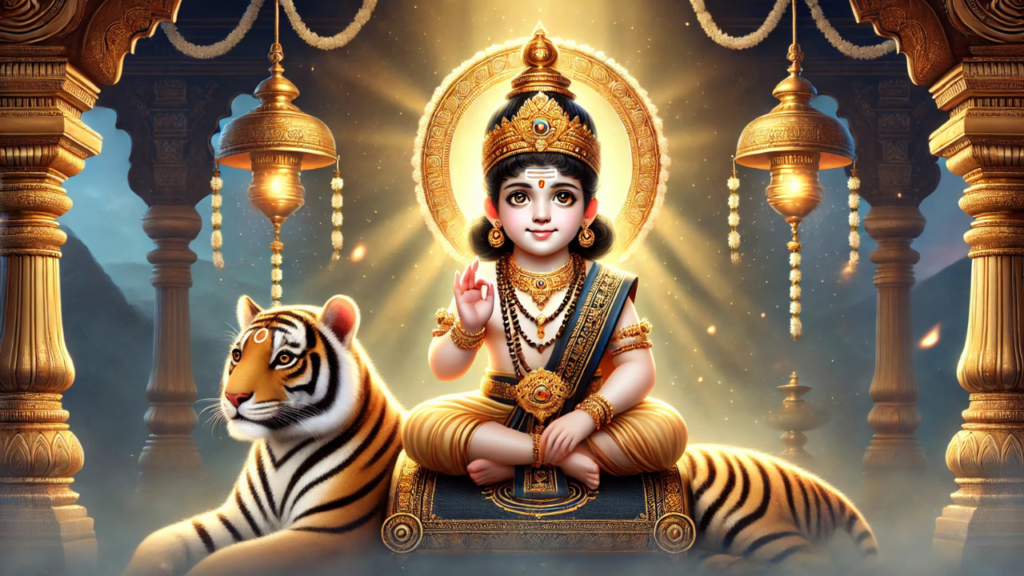Ayyappa god, also known as Dharma Shasta, is a revered Hindu deity, widely worshipped in South India, especially in Kerala. He is believed to be the son of Lord Shiva and Mohini (an incarnation of Lord Vishnu), embodying both Shaivite and Vaishnavite traditions. His legend is deeply rooted in devotion, righteousness (dharma), and the triumph of good over evil. The most famous temple dedicated to Ayyappa god is located in Sabarimala, Kerala, attracting millions of devotees every year.

The Birth and Divine Origins of Ayyappa god
According to Hindu mythology, Lord Ayyappa was born out of a divine purpose. The demoness Mahishi, sister of the demon Mahishasura, had received a boon that only the son of Lord Shiva and Lord Vishnu could kill her. To fulfill this prophecy, Lord Vishnu took the form of Mohini, and their union resulted in the birth of Ayyappa.
King Rajasekhara of the Pandalam dynasty, a devout ruler, discovered the child on the banks of the Pampa River. The king, who was childless, took the divine child as his own and named him Manikandan (meaning ‘one with a bell around his neck’). As he grew up, Manikandan exhibited extraordinary intelligence, strength, and divine powers.
The Legend of Mahishi’s Defeat
When Manikandan reached adolescence, the queen of Pandalam, under the influence of her minister, feigned illness and insisted that only tiger’s milk could cure her. The young prince embarked on a mission to the forest, where he encountered Mahishi. A fierce battle ensued, and Manikandan ultimately vanquished the demoness, fulfilling the prophecy. Following this, celestial beings appeared and revealed his true divine identity.
After completing his earthly mission, Manikandan ascended to Sabarimala, where he meditated and merged into the divine. The Sabarimala Temple was later built in his honor.
The Pilgrimage to Sabarimala
The Sabarimala pilgrimage is one of the most significant and arduous spiritual journeys in India. Millions of devotees from various backgrounds undertake this pilgrimage every year, observing strict austerities for 41 days before visiting the temple. The pilgrimage is unique as it symbolizes unity, equality, and spiritual discipline. Devotees, known as Ayyappas, wear black or blue attire, abstain from worldly pleasures, and chant “Swamiye Saranam Ayyappa” throughout their journey.
Significance of the Pilgrimage
- Vratham (Austerity Period): Devotees practice celibacy, follow a vegetarian diet, and lead a disciplined lifestyle.
- Irumudi Kettu: A sacred offering carried on the head, consisting of coconut filled with ghee, camphor, and other offerings.
- 18 Holy Steps (Pathinettam Padi): The steps leading to the sanctum represent different human vices that one must overcome to attain enlightenment.
Spiritual Teachings of Lord Ayyappa
Ayyappa god teachings emphasize devotion, self-discipline, and the importance of righteousness (dharma). His famous chant “Tat Tvam Asi” (That Thou Art) is a core philosophical teaching, signifying the unity of the soul with the divine. He is known as the deity of harmony, accepting devotees from all faiths, reinforcing his universal appeal.
Temples and Worship of Lord Ayyappa
While the Sabarimala Temple is the most famous, several other temples dedicated to Lord Ayyappa exist across India. Some notable ones include:
- Achankovil Temple (Kerala): Known for its idol of Ayyappa holding a medicinal stick.
- Kulathupuzha Temple (Kerala): Where Lord Ayyappa is worshipped as a child.
- Aryankavu Temple (Kerala): Depicting Ayyappa in the form of a married deity.
Devotees worship Lord Ayyappa by lighting lamps, chanting mantras, and observing fasting rituals. The annual Makaravilakku festival at Sabarimala, where a divine light appears in the sky, is one of the most anticipated events for Ayyappa devotees.
Conclusion
Lord Ayyappa remains a powerful symbol of devotion, discipline, and righteousness. His worship unites millions of devotees in a shared spiritual journey, teaching them the values of self-restraint, faith, and unity. The legend of Ayyappa, along with the grand pilgrimage to Sabarimala, continues to inspire people across generations, reinforcing the eternal principles of dharma and divine grace.
Swamiye Saranam Ayyappa!
